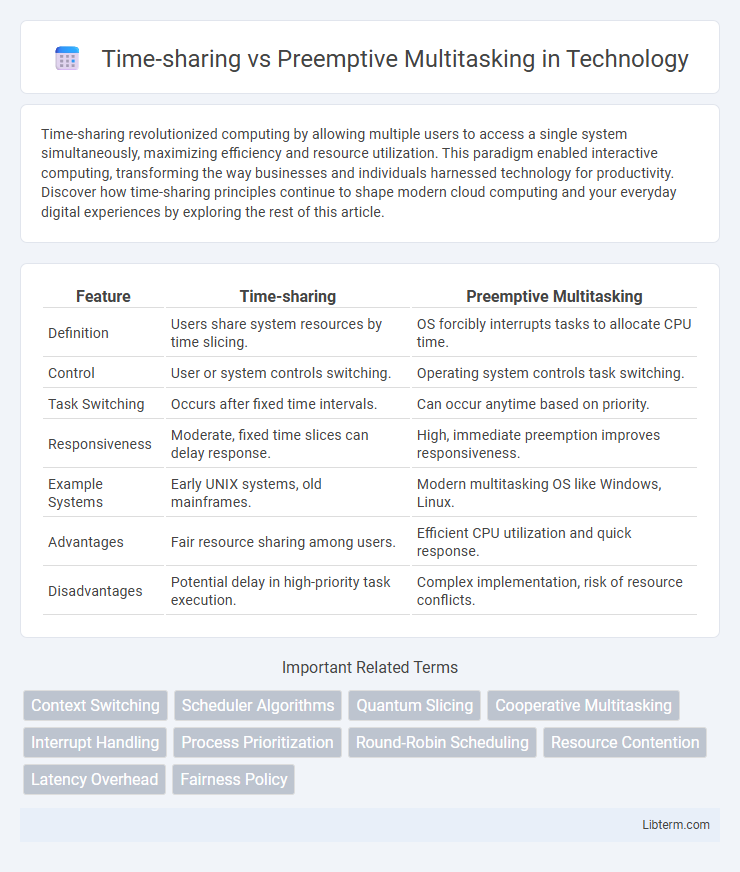Time-sharing revolutionized computing by allowing multiple users to access a single system simultaneously, maximizing efficiency and resource utilization. This paradigm enabled interactive computing, transforming the way businesses and individuals harnessed technology for productivity. Discover how time-sharing principles continue to shape modern cloud computing and your everyday digital experiences by exploring the rest of this article.
Table of Comparison
| Feature | Time-sharing | Preemptive Multitasking |
|---|---|---|
| Definition | Users share system resources by time slicing. | OS forcibly interrupts tasks to allocate CPU time. |
| Control | User or system controls switching. | Operating system controls task switching. |
| Task Switching | Occurs after fixed time intervals. | Can occur anytime based on priority. |
| Responsiveness | Moderate, fixed time slices can delay response. | High, immediate preemption improves responsiveness. |
| Example Systems | Early UNIX systems, old mainframes. | Modern multitasking OS like Windows, Linux. |
| Advantages | Fair resource sharing among users. | Efficient CPU utilization and quick response. |
| Disadvantages | Potential delay in high-priority task execution. | Complex implementation, risk of resource conflicts. |
Introduction to CPU Scheduling Techniques
Time-sharing and preemptive multitasking are fundamental CPU scheduling techniques designed to maximize processor utilization and ensure efficient execution of multiple processes. Time-sharing allocates fixed time slices to each process in a cyclic order, allowing multiple users to share system resources interactively. Preemptive multitasking enhances responsiveness by allowing the operating system to interrupt and switch processes based on priority, enabling dynamic and fair CPU allocation.
What is Time-Sharing in Operating Systems?
Time-sharing in operating systems is a method that allows multiple users to access a computer system simultaneously by rapidly switching the CPU among all active processes, creating an illusion of concurrent execution. This technique allocates fixed time slices to each process, ensuring efficient utilization of system resources and improved response time for interactive tasks. Time-sharing contrasts with preemptive multitasking by emphasizing equitable time distribution among users rather than dynamically prioritizing processes based on system interrupts or process priority.
Understanding Preemptive Multitasking
Preemptive multitasking enables an operating system to control CPU allocation by suspending a running task to start or resume another, improving responsiveness and efficiency. This process relies on timer interrupts to enforce task switching, ensuring that high-priority processes receive attention without waiting for lower-priority tasks to yield the CPU voluntarily. Preemptive multitasking contrasts with time-sharing by providing more granular control and better support for real-time applications, preventing any single process from monopolizing system resources.
Core Differences: Time-Sharing vs Preemptive Multitasking
Time-sharing distributes CPU time slices equally among multiple users or tasks to ensure fair access, enabling interactive computing environments. Preemptive multitasking allows the operating system to interrupt and suspend a running task to allocate CPU resources to higher-priority processes, optimizing system responsiveness and resource utilization. The core difference lies in time-sharing's focus on user-level fairness and scheduling fairness, while preemptive multitasking emphasizes priority-based process management and efficient CPU allocation.
Advantages of Time-Sharing Systems
Time-sharing systems maximize resource utilization by allowing multiple users to simultaneously access a computer system, improving overall system efficiency. These systems provide interactive computing environments, which enhance user experience through quick response times and better feedback for each active user. Time-sharing also simplifies system management by distributing computing time fairly, reducing the likelihood of any single process monopolizing CPU resources.
Benefits of Preemptive Multitasking
Preemptive multitasking enhances system responsiveness by allowing the operating system to allocate CPU time based on priority, reducing the risk of any single process monopolizing resources. It improves system stability and security by preventing uncooperative or malfunctioning applications from freezing the entire system. This approach also supports better real-time task management, ensuring critical processes receive timely CPU access for smoother performance.
Key Drawbacks and Limitations
Time-sharing systems face limitations such as inefficient resource allocation due to fixed time slices, leading to possible CPU underutilization and increased context switching overhead. Preemptive multitasking can cause issues like race conditions and requires complex synchronization mechanisms, risking data corruption and increased system complexity. Both approaches may experience latency challenges impacting real-time application performance and overall system responsiveness.
Real-World Applications and Use Cases
Time-sharing systems maximize CPU utilization by allocating fixed time slices to each user process, making them ideal for interactive environments like mainframe computing and educational labs where multiple users require responsive access. Preemptive multitasking enhances system responsiveness by allowing the OS to interrupt and switch tasks based on priority, prominently used in modern operating systems such as Windows, Linux, and macOS to efficiently manage background services, real-time applications, and multitasking workloads. Real-time embedded systems in automotive control, robotics, and telecommunications rely on preemptive multitasking to guarantee timely execution of critical tasks, ensuring system stability and performance.
Performance Comparison: Efficiency and Responsiveness
Time-sharing systems allocate CPU time slices to each process, ensuring fairness but potentially leading to latency due to fixed quantum lengths. Preemptive multitasking dynamically interrupts processes based on priority and system load, enhancing responsiveness by quickly addressing high-priority tasks. Efficiency in preemptive multitasking is often superior because it minimizes idle CPU time and adapts to real-time demands, though it can introduce overhead from frequent context switches.
Conclusion: Choosing the Right Multitasking Method
Selecting the optimal multitasking method depends on the specific system requirements and resource constraints. Time-sharing excels in environments needing predictable, fair CPU allocation for multiple users, while preemptive multitasking offers superior responsiveness and control in real-time or complex applications. Evaluating factors such as system load, latency tolerance, and process priority ensures the best multitasking strategy for performance and efficiency.
Time-sharing Infographic

 libterm.com
libterm.com